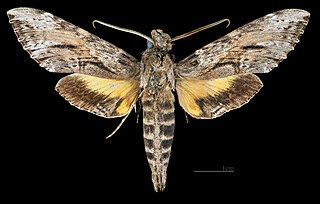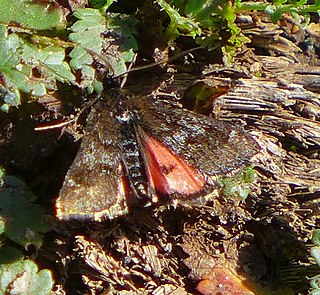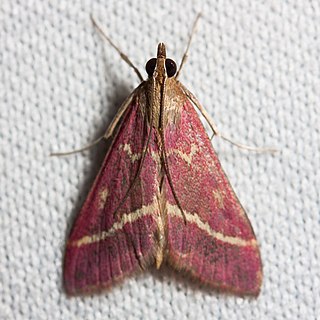
The Noctuidae, commonly known as owlet moths, cutworms or armyworms, are a family of moths. They are considered the most controversial family in the superfamily Noctuoidea because many of the clades are constantly changing, along with the other families of the Noctuoidea. It was considered the largest family in Lepidoptera for a long time, but after regrouping Lymantriinae, Catocalinae and Calpinae within the family Erebidae, the latter holds this title now. Currently, Noctuidae is the second largest family in Noctuoidea, with about 1,089 genera and 11,772 species. This classification is still contingent, as more changes continue to appear between Noctuidae and Erebidae.

Crambidae comprises the grass moth family of lepidopterans. They are variable in appearance, with the nominal subfamily Crambinae taking up closely folded postures on grass stems where they are inconspicuous, while other subfamilies include brightly coloured and patterned insects that rest in wing-spread attitudes.

The Pyralidae, commonly called pyralid moths, snout moths or grass moths, are a family of Lepidoptera in the ditrysian superfamily Pyraloidea. In many classifications, the grass moths (Crambidae) are included in the Pyralidae as a subfamily, making the combined group one of the largest families in the Lepidoptera. The latest review by Eugene G. Munroe and Maria Alma Solis retain the Crambidae as a full family of Pyraloidea.

Nelumbo lutea is a species of flowering plant in the family Nelumbonaceae. Common names include American lotus, yellow lotus, water-chinquapin, and volée. It is native to North America. The botanical name Nelumbo lutea Willd. is the currently recognized name for this species, which has been classified under the former names Nelumbium luteum and Nelumbo pentapetala, among others.

Green lacewings are insects in the large family Chrysopidae of the order Neuroptera. There are about 85 genera and 1,300–2,000 species in this widespread group. Members of the genera Chrysopa and Chrysoperla are very common in North America and Europe; they are very similar and many of their species have been moved from one genus to the other time and again, and in the nonscientific literature assignment to Chrysopa and Chrysoperla can rarely be relied upon. Since they are the most familiar neuropterans to many people, they are often simply called "lacewings". Since most of the diversity of Neuroptera are properly referred to as some sort of "lacewing", common lacewings is preferable.

The Pyraloidea are a moth superfamily containing about 16,000 described species worldwide, and probably at least as many more remain to be described. They are generally fairly small moths, and as such, they have been traditionally associated with the paraphyletic Microlepidoptera.

Isognathus rimosa, the rimosus sphinx, is a moth of the family Sphingidae. The species was first described by Augustus Radcliffe Grote in 1865.

The European corn borer, also known as the European corn worm or European high-flyer, is a moth of the family Crambidae. It is a pest of grain, particularly maize. The insect is native to Europe, originally infesting varieties of millet, including broom corn. The European corn borer was first reported in North America in 1917 in Massachusetts, but was probably introduced from Europe several years earlier. Since its initial discovery in the Americas, the insect has spread into Canada and westwards across the United States to the Rocky Mountains.

Ostrinia is a genus of moths in the family Crambidae described by Jacob Hübner in 1825. Several of them, including the European corn borer, are agricultural pests.
Mimoschinia is a genus of moths of the family Crambidae. It contains only one species, Mimoschinia rufofascialis, the rufous-banded pyralid moth or barberpole caterpillar, which is found in the Caribbean, from Alberta to British Columbia, south to Texas and California and in Mexico.

Globia oblonga, the oblong sedge borer, is a moth of the family Noctuidae. The species was first described by Augustus Radcliffe Grote in 1882. It is found in parts of Canada and the United States

Globia subflava, the subflava sedge borer or yellow sedge borer, is a moth of the family Noctuidae. The species was first described by Augustus Radcliffe Grote in 1882. It is found in North America from Nova Scotia west to British Columbia, south to New Jersey in the east and Utah and California in the west.

Metalectra discalis, the common fungus moth, is a moth of the family Erebidae. The species was first described by Augustus Radcliffe Grote in 1876. It is found in North America from Wisconsin to Quebec and Maine, south to Florida, west to Texas and Missouri, north to Ontario.

Diatraea crambidoides, the southern cornstalk borer moth, is a species of moth of the family Crambidae described by Augustus Radcliffe Grote in 1880. It is found in North America, from Alabama and northern Florida to Ohio and Maryland. Its wingspan is 15–40 mm, and adults are straw colored to dull white. The forewings are slightly darker than the hindwings. There are two generations per year.
Ostrinia scapulalis, the adzuki bean borer or adzuki bean worm, is a species of moth in the family Crambidae. It was described by Francis Walker in 1859. It is one of 20 moths in the genus Ostrinia and is of Eurasian origin. The larvae have a gray mid-dorsal line and can be light pink or beige. The adult adzuki bean borer has a yellowish-brown forewing with jagged lines and variable darker shading, with a wingspan that ranges from 20 to 32 mm. The moths of this species are nocturnal and tend to be attracted to light.

Ostrinia furnacalis is a species of moth in the family Crambidae, the grass moths. It was described by Achille Guenée in 1854 and is known by the common name Asian corn borer since this species is found in Asia and feeds mainly on corn crop. The moth is found from China to Australia, including in Java, Sulawesi, the Philippines, Borneo, New Guinea, the Solomon Islands, and Micronesia. The Asian corn borer is part of the species complex, Ostrinia, in which members are difficult to distinguish based on appearance. Other Ostrinia such as O. orientalis, O. scapulalis, O. zealis, and O. zaguliaevi can occur with O. furnacalis, and the taxa can be hard to tell apart.
Ostrinia obumbratalis, the smartweed borer, is a moth in the family Crambidae. It was described by Julius Lederer in 1863. It is found in North America, where it has been recorded from New Brunswick and Manitoba to Louisiana and Florida.
Ostrinia ovalipennis is a moth in the family Crambidae. It was described by Suguru Ohno in 2003. It is found in Japan, where it has been recorded from Honshu and Hokkaido.

Pyrausta dapalis is a moth in the family Crambidae. It was described by Augustus Radcliffe Grote in 1881. It is found in western North America, where it has been recorded from California and Oregon.

Pyrausta volupialis, the volupial pyrausta moth, is a moth in the family Crambidae. It was described by Augustus Radcliffe Grote in 1877. It is found in North America, where it has been recorded from Oklahoma, Utah, Texas, Colorado, New Mexico, Arizona and California to Chiapas, Mexico.















